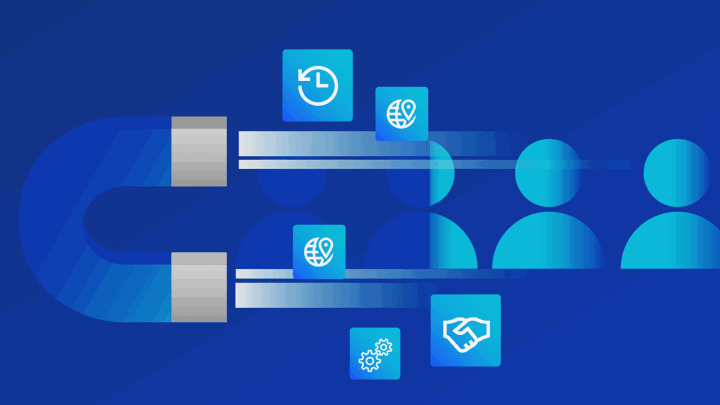Customer acquisition strategies you should try in 2020
- By Georgia James - Feb 26, 2020
If your business wants to scale up and sustain your growth over time, you not only need a high level of customer retention, you also need a solid strategy for attracting new customers. However, customer acquisition isn’t easy. If it were, there wouldn’t be countless lead generation agencies vying for your marketing budget. Nor is it cheap. Customer acquisition costs have increased by nearly 50% in the last five years.
If customer acquisition is your top-priority in 2020, here are four tested and proven strategies to help you hit your targets.
Start with loyal customers

According to a HubSpot study, customer references and word-of-mouth referrals are the two most trusted information sources when making a purchase. If you’re not already tapping your existing customer base for referrals, you need to be.
While many of your customers won’t proactively sell your product or service to their network, you’re likely to have at least a few customers who love your solution enough to provide referrals. Depending on your relationship with clients, there are two methods to gain new customers from existing ones: through a formal referral program, or simply by regularly asking them.
How to set up a simple referral program
If you serve a small number of clients or your business is very high-touch, a simple referral process may be all you need. Individual consultants, coaches, professional services, and niche technology solutions fall into this category.
When asking for referrals, timing is everything. A customer is far more likely to recommend you to others if they’ve just experienced positive results from working with you. Establish a process or customizable script you can use to reply to happy customers in the moment they’re most satisfied with your work.
Get started: Something as simple as a line or two in an email can lead to new customers — for example: “I’m so happy to hear it’s working for you! While you’re here, can you think of 2-3 other people you know who might be looking for the same results?” Provide your clients with a referral script template they can customize to make it easy for them to put you in touch with their network.
How to set up a formal referral program
While an in-the-moment process is perfect for businesses that serve just a few clients, it’s impractical for larger businesses or those that serve thousands of clients. That’s where incentivized referrals come into play.
Get started: Establish a referral program that incentivizes customers through perks such as discounts or commissions to spread the word. Educate your team on identifying referral opportunities and give them the tools to empower your customers to bring in new business. Provide referral links, site badges, and free sales and marketing materials, along with contact with an expert on your team to make it as easy as possible for your customers to refer your business.
Work with partners

Don’t dismiss the value that partnerships can bring to your business. A partnership between two related businesses can bring expanded reach, more customers, shared leads, and additional revenue to both organizations.
In a B2B setting, partnerships can take on a variety of forms, including other brands and industry experts, but it’s important that your solution complements the offerings from the other business and that you share a similar target audience. Your selected partner should of course have a sufficiently large and engaged audience.
Here are a couple of examples of types of partners for a SaaS company:
- Another SaaS company that offers a complementary solution, like a CRM company and a process automation tool.
- A technology hardware provider, like a POS company or IoT company
Get started: Run a co-branded joint marketing campaign with your partner in order to cross-sell each other’s solution, for example, creating co-branded content that can be promoted by both businesses. This way, you’ll tap into your partner’s customer base, creating more brand awareness and generating more potential leads that can be shared out between you and your partner.
Be patient with content marketing

For many companies, the most important source for acquiring new customers is their website. The two main techniques for attracting new customers here - and increasing your chance of a conversion - are content marketing and SEO.
Content marketing is still a powerful tactic for B2B companies, but the one mistake most companies make is giving up on it too soon. The truth is, it’s difficult to stand out in such a saturated landscape. The sheer volume of internet content being created and promoted today is dizzying:
- 400 new hours of video are uploaded to YouTube every minute
- 293 billion emails sent in 2019
- 4 million blog posts published every day in 2019
And these numbers are growing, along with the number of people using the internet (4.54 billion users as of January 2020).
The key to success in content marketing is to view it as a long-term strategy, and continue publishing content even when audience growth is slow. Every leading content creator had to start at square one, with no followers or subscribers. The ones who last are the ones who publish valuable content on a consistent basis, often over the course of years, not months.
Get started: Be strategic about the channels you publish on. Only very large brands can afford to consistently create meaningful content on every channel, so go deep with your efforts when you’re starting out. Ask yourself:
- Where do your customers go to learn about solutions like yours? Do they learn using LinkedIn content, ask their friends on Facebook, or watch YouTube videos? Do they subscribe to blogs and interact with brands via email? Choose one or two of these channels to focus on.
- How do your customers prefer to consume content? Some B2B customers prefer written and longform content that they can read at their own pace during the workday, while others may prefer podcasts or webinar recordings. If your product or solution makes the most sense in a visual demo, video may be the best medium for your content marketing.
No matter the channel and type of media you focus on, search is an essential component of your customer marketing strategy, especially for B2B companies. Research has shown that 71% of B2B buyers begin their research with a Google search, and most of these make their buying decision using only digital content. If your solution isn’t coming up at the top of search results, you’re missing out on a huge opportunity.
Get started: Combine your organic (SEO) strategy with paid advertising (PPC). Additionally, making simple technical SEO changes to your website will improve search rankings for your pages and help new customers discover you.
One last note about content marketing. It often takes customers several interactions with your brand to make a purchase decision, especially for the longer buying cycles you often see in B2B sales. Once you’ve attracted a lead with a piece of content, it’s important to continue providing valuable, personalized content on a regular basis to keep your brand and solution top-of-mind at every step of the customer journey
Entice prospects in with ‘try before you buy’

Providing something for free is a time-tested way to attract potential customers. When we’re talking about SaaS, paid customer acquisition often starts with a free trial or ‘freemium’ version of the product. You could also consider providing a free assessment or consultation, a guide, or other resources.
While your goal might be to obtain contact information so you can remarket to your leads, your real target should be to provide a positive first impression of your product or service.
According to UX designer Samuel Hulick, the first five minutes a SaaS user spends on your product (signing up and getting started) are the most important. If there is anything frustrating or confusing about getting started, you will have a difficult time winning back that potential customer.
Get started: A good rule of thumb when using the freemium model for customer acquisition is to be original, valuable, and memorable. Your customers are inundated with “free” nowadays, and just because something is free doesn’t mean it’s worth their time or attention. If you’re considering implementing a “freemium” version of your solution, do your research first. Put together a focus group or create a survey to determine which key features are most important to your market. Do a soft launch of your freemium service to a select group of customers and study the data. Look at the number of active users, their onboarding questions, support tickets, and their engagement with your brand to determine if the “free” option is providing real value.
Evaluate your offering
Great marketing starts with having something worthwhile to sell, so if you’re investing heavily in customer acquisition and still not seeing the results you’re hoping for, revisit your offering and consider how you can improve to attract the customers you want.
It may help to think of customer acquisition as one-part lead generation and one-part customer retention. While you do need a healthy number of leads in your sales pipeline to keep business growing, it’s every bit as important to invest in your current customers by improving your product, discovering new ways to serve the market, and creating something that partners and your happiest customers will endorse.

